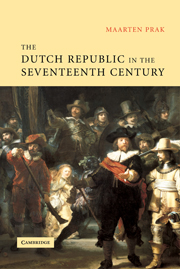Book contents
- Frontmatter
- Contents
- List of illustrations
- Acknowledgements
- Chronology
- Map
- Introduction: The enigma of the Republic
- 1 A turbulent beginning
- Part I War without end
- Part II Golden Age: economy and society
- Part III Unity and discord: politics and governance
- Part IV An urban society
- Conclusion: The end of the Golden Age
- Further reading
- Index
Conclusion: The end of the Golden Age
Published online by Cambridge University Press: 05 February 2015
- Frontmatter
- Contents
- List of illustrations
- Acknowledgements
- Chronology
- Map
- Introduction: The enigma of the Republic
- 1 A turbulent beginning
- Part I War without end
- Part II Golden Age: economy and society
- Part III Unity and discord: politics and governance
- Part IV An urban society
- Conclusion: The end of the Golden Age
- Further reading
- Index
Summary
Some time between 1672 and 1715 the Golden Age came to an end. It is impossible to give a precise date, but in the winter of 1715, when the Union treasury had to be closed because there was no money left to pay the interest on government bonds, insiders saw the writing on the wall. The state bankruptcy, for that is what it was, lasted nine months, after which creditors had to settle for lower interest rates on their investments. As the Dutch ambassador in London wrote in a letter dated 26 November 1715, ‘The Republic is in a bad state and other countries know this all too well.’
These financial troubles were no coincidence, but rather a symptom of deep-seated problems that had been brewing for decades. The growth of the cities, which had been such a dynamic factor in the rise of the Republic, had come to a standstill in the last decades of the seventeenth century. Only Amsterdam was still expanding, owing in part to its relaxation of the requirements for citizenship, such as the lowering of citizenship fees, which enabled less well-to-do burghers to acquire citizenship. Despite these efforts to boost population growth, the fourth extension to the city, carried out in the 1660s, did not become fully developed until the nineteenth century. More tellingly, large-scale public works became less and less frequent.
- Type
- Chapter
- Information
- The Dutch Republic in the Seventeenth CenturyThe Golden Age, pp. 263 - 273Publisher: Cambridge University PressPrint publication year: 2005



